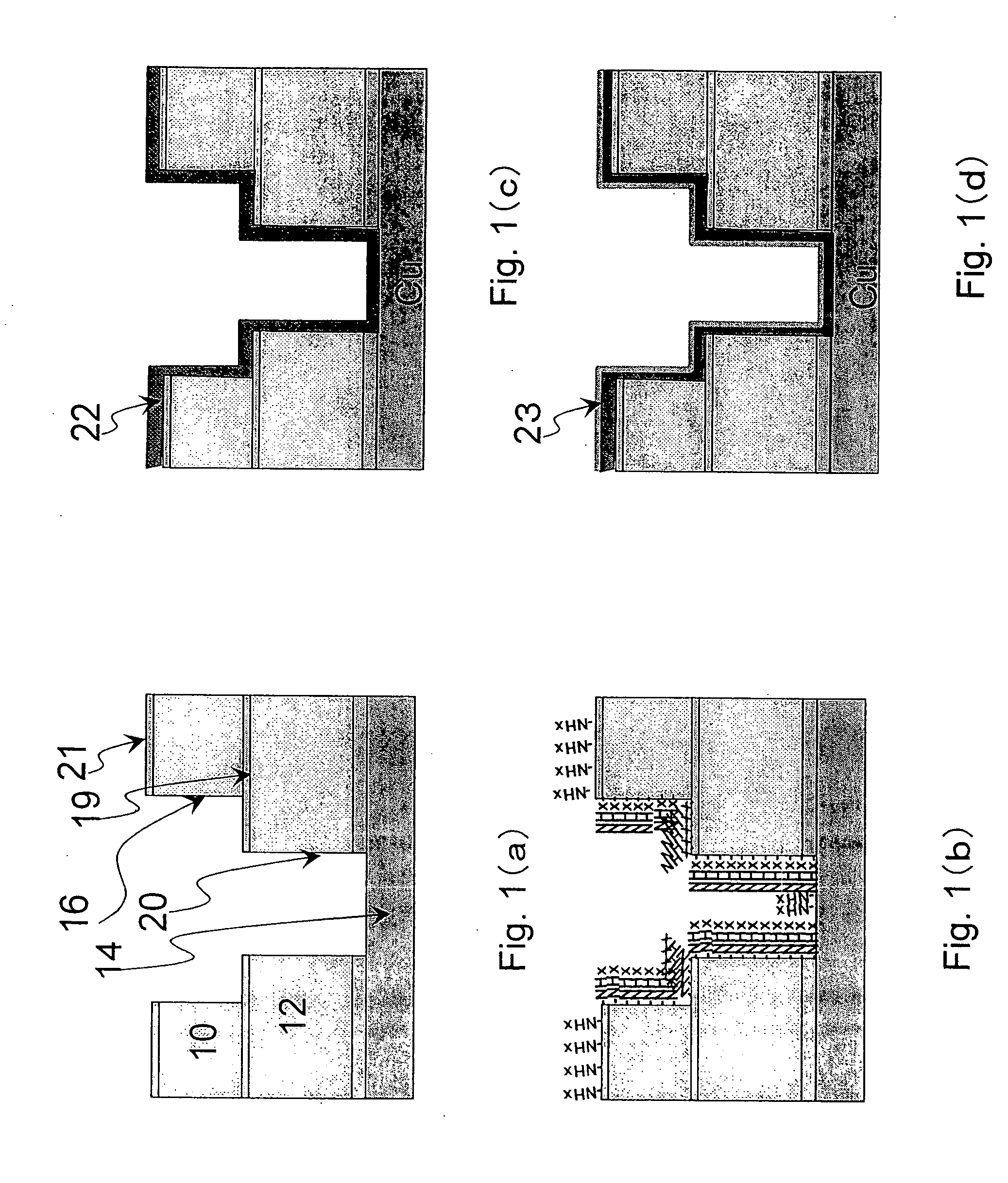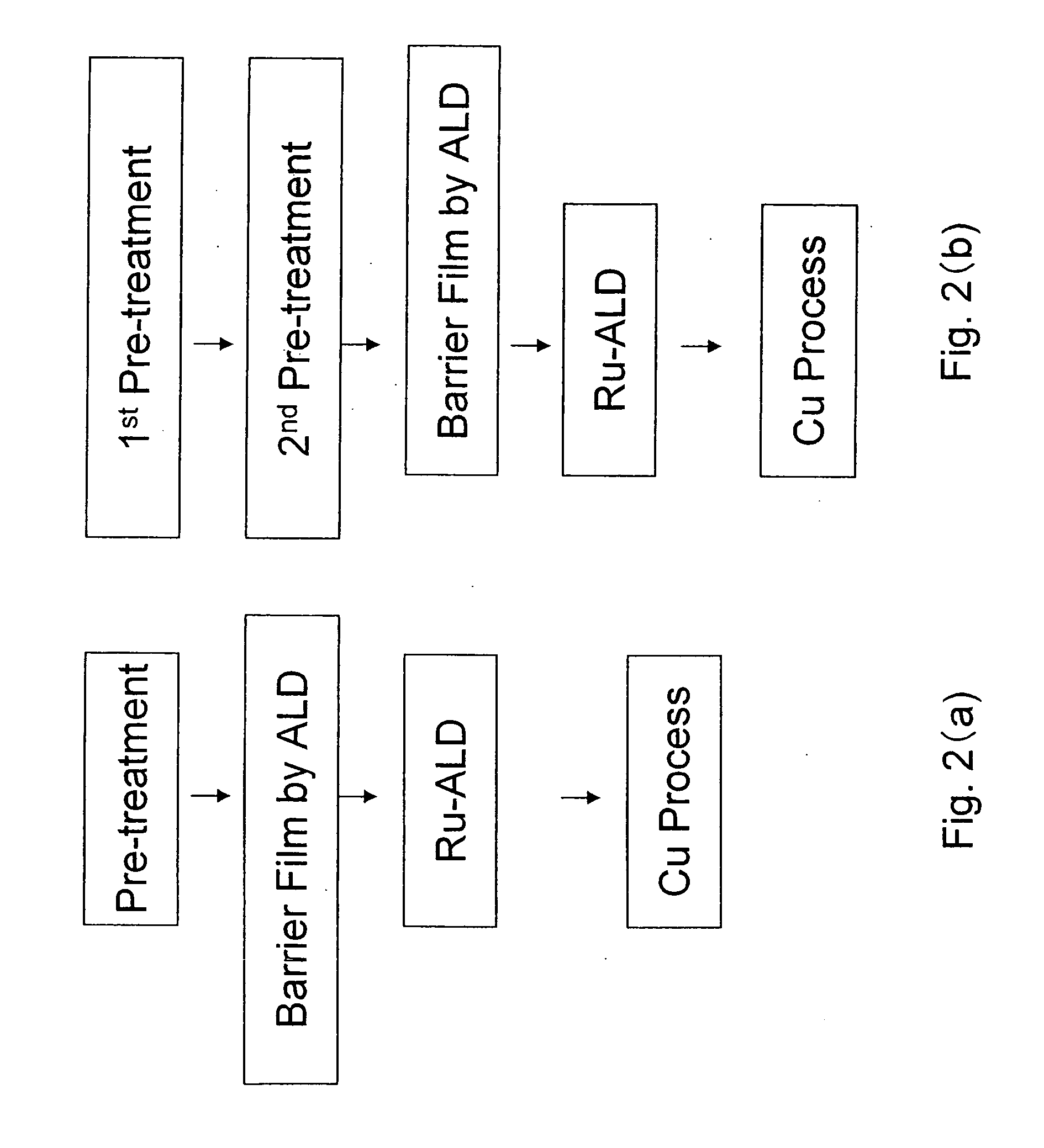Method for forming metal wiring structure
- Summary
- Abstract
- Description
- Claims
- Application Information
AI Technical Summary
Benefits of technology
Problems solved by technology
Method used
Image
Examples
example 1
[0216] This example illustrates a process of lining with a metal film, which becomes a copper barrier film, the entire surface of trenches and contact vias of a dual damascene structure to create a semiconductor element. Specifically, the process relates to the step to pre-treat the entire surface of trenches (16) and contact vias (20) of the dual damascene structure, the step to form a tungsten carbon nitride WNC film as a metal barrier film, and the step to form a Ru film, corresponding to FIGS. 1(b), (c) and (d), respectively. These steps correspond to the flow shown in FIG. 5(a) or (b), and the steps corresponding to FIGS. 1(b), (c) and (d) are implemented using an apparatus having the structure shown in FIG. 5(c). A semiconductor substrate on which the structure shown in the schematic cross-section drawing per FIG. 1(a) was transferred from the cassette box (100) to the load lock chamber (102) by means of the atmospheric pressure robot (101), as shown in FIG. 5(c). After the ch...
example 1-1
[0226] FIGS. 8(a) and (b) show cross-section images of a trench structure where a WNC-ALD film was formed, after pre-treatment, on a SiOC film (201) formed by plasma CVD (Aurora ULKTM film by ASM). Pre-treatment 2 shown in Tables 3 and 4 was implemented, after which a WNC film was formed using the WNC-ALD formation method explained above. FIG. 8(a) shows an extremely uniform, smooth WNC film (202) formed at a RF power of 100 W. FIG. 8(b) shows a similarly uniform, smooth WNC film (203) formed at a RF power of 300 W.
example 1-2
[0227]FIG. 9(a) and (b) show film conditions on a plasma CVD film (201) (Aurora ULKTM film by ASM), when the conditions of pre-treatments 1 and 2 shown in Table 3 were implemented separately. FIG. 9(a) shows the condition after pre-treatment 1 in which plasma process using H2 / He mixture gas was performed. As shown by the TEM cross-section image of the trench, the WNC-ALD film (204) is neither continuous nor smooth on the side face. The purpose of pre-treatment 1 is to reduce copper oxide film, and this image shows that this pre-treatment alone is not always effective in introducing amino groups to the surface of low dielectric constant film. On the other hand, FIG. 9(b) shows the condition after performing pre-treatment 2 using H2 / H2 / N2 mixture gas. As shown, the WNC-ALD film (205) is continuous and smooth even on the side face of the trench. Since there is not need to reduce copper oxide film here, pre-treatment 1 can be omitted. The same shape was also obtained under the pre-treat...
PUM
| Property | Measurement | Unit |
|---|---|---|
| Temperature | aaaaa | aaaaa |
| Temperature | aaaaa | aaaaa |
| Shrinkage | aaaaa | aaaaa |
Abstract
Description
Claims
Application Information
 Login to View More
Login to View More - R&D
- Intellectual Property
- Life Sciences
- Materials
- Tech Scout
- Unparalleled Data Quality
- Higher Quality Content
- 60% Fewer Hallucinations
Browse by: Latest US Patents, China's latest patents, Technical Efficacy Thesaurus, Application Domain, Technology Topic, Popular Technical Reports.
© 2025 PatSnap. All rights reserved.Legal|Privacy policy|Modern Slavery Act Transparency Statement|Sitemap|About US| Contact US: help@patsnap.com



